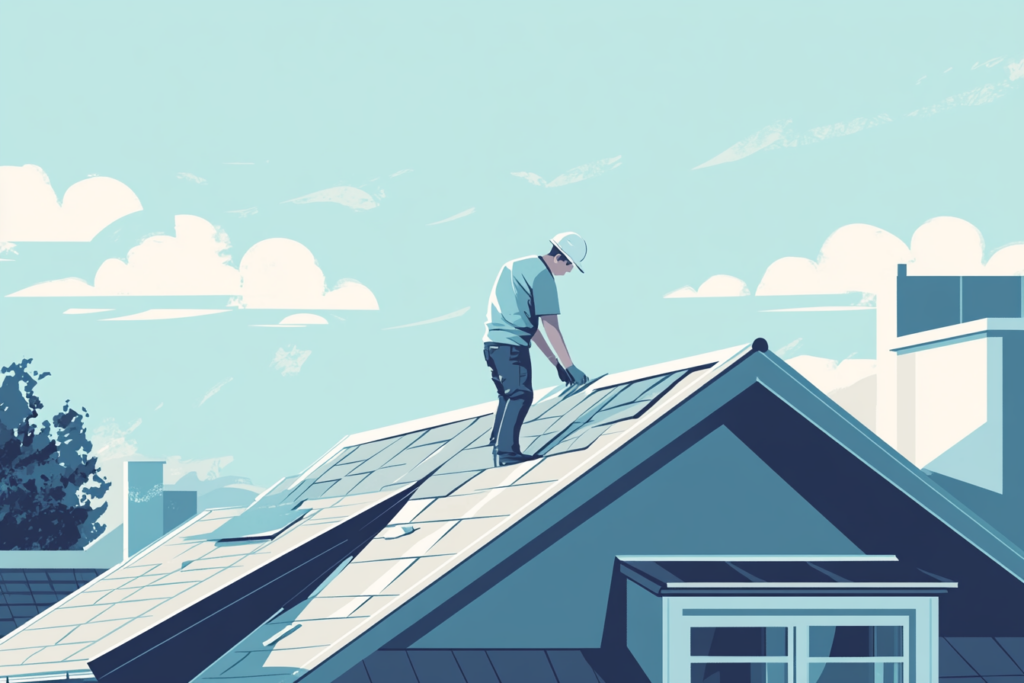There are six basic parts to any roof: framing system, deck, underlayment, ice and water shield, flashing and roofing material. When something damages your roof, it can be something surface-level, where you just need to replace some missing shingles and the ice and water shield underneath. Damage can also extend through all the layers of your roof down to the framing.
If a storm tore through, caused wind damage to your roof or downed branches hitting the surface or cracking tiles, you’ll need to choose between isolated repairs and replacing the entire roof.
In this guide, we look at some of the most common signs of damage and how to tell if repair or replacement is the more economical solution.
How Extensive is the Damage?
No two roofing materials respond to damage in the same way. Some materials are great at handling wind and impact damage but might be vulnerable to high humidity and mold. To determine the level of damage, you’ll need to inspect the roof for structural issues, environmental damage, water damage, or leaks.
Assess the Roof Structure for Signs of Sagging or Shifting
Structural integrity is crucial for roof longevity. Over time, even durable materials can experience wear in the underlying structure, causing the roof to sag or shift. Structural damage almost always means that you’ll need a new roof, so if you notice any of the signs below, it’s likely time to skip the patch and go right for a replacement.
- Sagging: This is particularly noticeable in areas like valleys and ridges. Sagging can indicate compromised support beams or rafters, often from water damage or prolonged exposure to heavy loads, such as snow. All roofing types are vulnerable to sagging, but asphalt shingle roofs are especially prone to this over time.
- Shifting or Buckling: Clay tiles are heavy, and if installed on a weaker frame, the weight can gradually cause structural shifting. Inspect for gaps or separation between tiles or shakes, which could signal a shifting roof deck.
Weather and environmental factors are some of the most critical stressors on roofing materials. Storm damage averages more than $12,000 in repair costs for homeowners, according to Angi, but actual expenses can vary widely.
Other environmental factors that might tip the balance between repairs or replacement could include sun exposure, temperatures and moisture levels. UV rays make shingles brittle over time and cause metal to expand and contract (leading to loosening of fasteners). High temperatures and humidity levels can create the perfect environment for mold and algae to grow while encouraging rot in the structure’s wooden elements.
When the issue is environmental, that often means the damage is cumulative over time. Since this type of damage tends to affect large sections of the roof, you’re likely to need a new one if the issue is sun exposure or humidity levels.
Inspect for Water Damage and Leaks
Water damage can be subtle but often indicates more extensive underlying issues. Checking both the roof’s exterior and your home’s interior is essential.
- Exterior Inspection: Look for pooling water, particularly on flat or low-slope roofs. Dark spots or stains around roof valleys, flashing, or vent pipes can signal water infiltration. Any soft or sagging areas on shingle roofs may suggest waterlogged decking beneath.
- Interior Inspection: Inside your home, look for any water stains on ceilings and walls, indicating a leaky roof. Attics are particularly vulnerable to hidden leaks, so check for signs of mold, musty odors, or damp insulation. Water damage in the attic may reveal problems with roof decking or inadequate ventilation, which can exacerbate roof wear.
The U.S. General Services Administration recommends specific exterior and interior inspections for flat roofs. It’s important to remember that roof slope plays an important role in how damage develops and the total cost of repair versus replacement of the roofing surface.
What’s the Roof Made Of?

Longer-lasting roofing materials cost more. That means replacing a slate roof, one of the most durable options, is a lot more expensive than replacing asphalt shingles. These materials also show wear differently. If you’re trying to assess the level of damage to determine whether repairs might be an option, start by looking for signs of aging, which can mean your roof is reaching the end of its usable life.
- Asphalt Shingles: Asphalt shingles are common and affordable, but they can be prone to issues like curling, cracking, and granule loss.
- Metal Roofing: Metal roofs are known for durability but can still suffer from dents, rust, and corrosion, especially in regions with high humidity.
- Clay and Concrete Tiles: While resilient, clay and concrete tiles can crack or break if impacted by heavy debris.
The Big Picture
There’s no smoking gun when it comes to roof maintenance. A general rule of thumb for your roof is to choose a replacement if more than 30% of the roof surface needs repairs. Repairs tend to be more affordable if the damage is minor and contained to smaller segments.
But an older roof might need replacement anyway. A slate roof might be worth repairing for a century or more. Ultimately, the best way to decide between repairs and replacement for your roof is to get several estimates and compare recommendations from roofing professionals.
You might also be interested in: 5 Reasons Why Proper Roof Ventilation Matters




